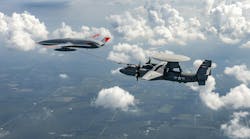Unmanned vehicles are becoming plentiful on–and over–the modern battlefield, yet these automated systems until recently have been seen largely as military curiosities, not standard equipment. That’s all about to change.
In the future, we’ll look back at this year, 2009, as the time when unmanned vehicles truly graduated from boot camp, and started joining the ranks in the regular forces–becoming as common in the military arsenal as the infantry rifle, the Humvee utility vehicle, and the combat radio. In fact, we may see the first glimpses of a new military era when unmanned vehicles represent the norm on the battlefield, not the exception, and perhaps when manned vehicles will see use only in specialized missions.
Think of it: jet fighters, reconnaissance aircraft, and cargo air transports all flying without pilots aboard. On the ground will be reconnaissance drones, unmanned cargo trucks, and eventually unmanned cannons, gun platforms, and grenade launchers adding fire support to infantry assaults. Inside this special unmanned vehicle section, you see the evidence of this gathering new era.
Turn inside, and start with the special report on unmanned aerial vehicles (UAV) by expert J.R. Wilson. Not only is the idea of combat UAVs becoming well accepted, but unmanned aircraft also are poised to fill roles in border security, forest fire detection and suppression, as well as police and public safety work. We also have a big story on unmanned ground vehicles, which ran in the Military & Aerospace Electronics June print issue, but which simply could not fit into this supplement. In that story, which you can find online by copying the URL http://bit.ly/fF379 into your Web browser, you’ll read testimony that military robots for ground applications are coming into their own. There’s more we couldn’t fit in here, but that you can see on the Web. For some of the latest research in unmanned underwater vehicles that U.S. Navy officials are considering for reconnaissance, mine detection and destruction, and even for anti-submarine warfare, copy the URL http://bit.ly/19YVPc into your Web browser.
The military is getting ready to deploy the military robot for future applications like reconnaissance, surveillance, and target acquisition (RSTA); security and engineering, such as obstacle breaching; medical applications like removing wounded from the battlefield; maintenance of vehicles and machinery; target acquisition and designation; mine and IED detection and disposal; and perhaps armed robotic applications.
Think this is still science fiction? Don’t believe us; just look at my analysis of the 2010 U.S. Department of Defense budget proposals. This nation is getting ready to spend more on unmanned vehicles than ever before. Next year, the DOD wants to spend at least $5.4 billion on unmanned vehicles, which is up by more than 18 percent from this year. The Army, in fact, is ready to start procuring unmanned vehicles for air and ground applications in strikingly substantial numbers. Research and development for unmanned vehicles, meanwhile, is proceeding full-steam ahead.
In response to all this, technology suppliers in the defense industry are not standing still. Scan over the extensive section on new products for unmanned vehicle applications to see who is doing what to capitalize on the tectonic shift we’re seeing in unmanned vehicle development and use. It’s a brave new world we’re facing when it comes to unmanned vehicles. This section will answer many of your questions.
By John Keller
Editor-in-Chief


